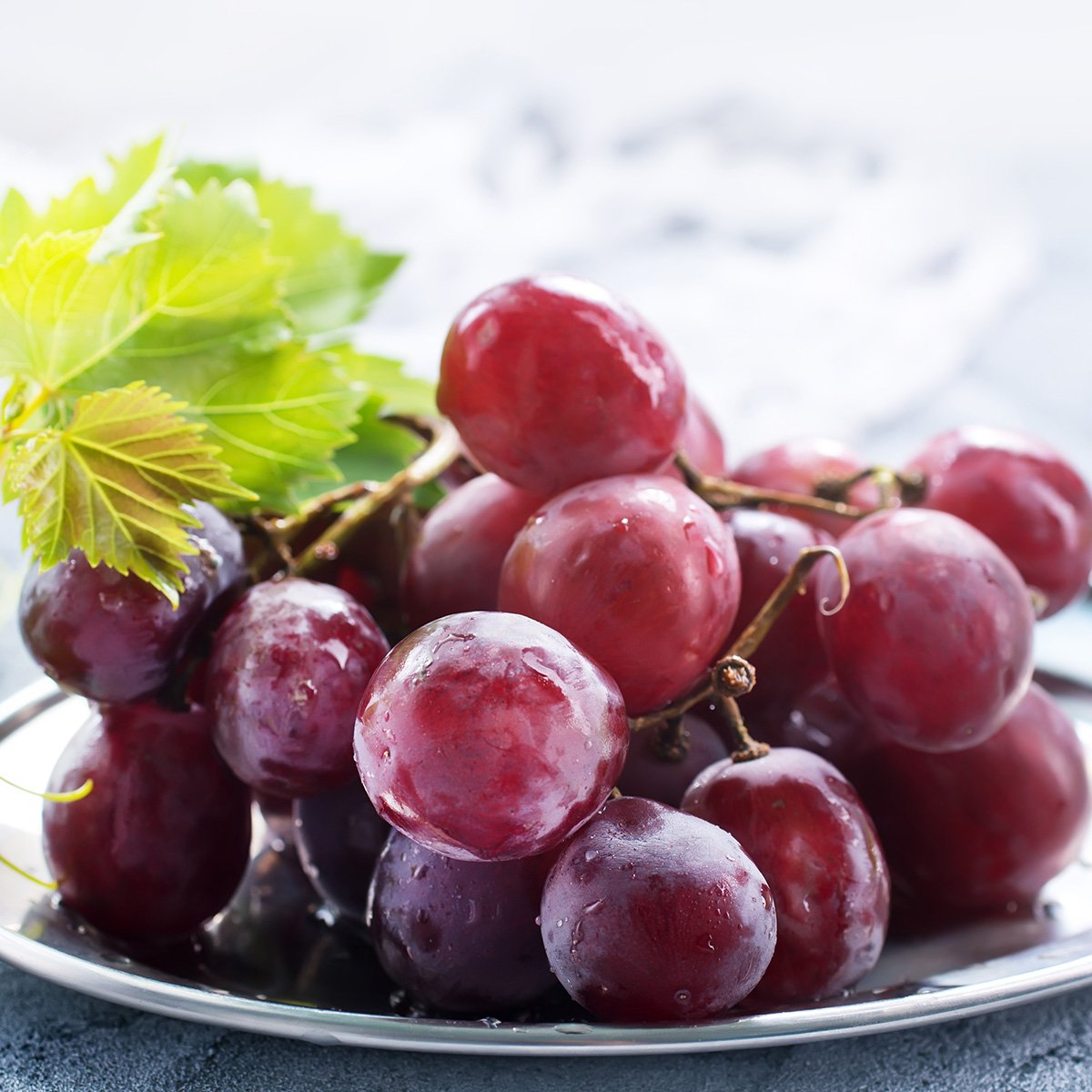I am currently on vacation in Barcelona and am amazed at the wide selection of fresh, inexpensive fruits and vegetables. La Boqueria Food Market off La Rambla offers an incredible array of mouth-watering fruits that look like they might just have been Photoshopped.

Just walking around the market makes me think that my telomeres are getting longer (telomeres are the bits at the end of our chromosomes that shorten as we age).
Just being here makes me want to write an article on grapes to see if they are as good as they look (and taste)?
Table of Contents
What are Grapes?
Grapes are small berries that belong to the grapevine plant family, or genus Vitis.
Dionysus, or Bacchus, is the Greek god of grapes, which suggests that grapes have been cultivated since at least 11,000 BC. Numerous references to grapes can also be found in the Bible. I think we can safely assume that grapes are not a modern-day discovery.
Grapes grow best in temperate climates, which offer the ideal mix of moisture and sunshine. The top ten countries for grape production are South Africa, Spain, Italy, Greece, France, the USA, Chile, Iran, Argentina, Turkey, and now China. Funny, I would never have associated grapes with China.
The North American grapes are Muscadina rotundifolia and the main European grape is Vitis vinifera (1).
- Black grapes typically contain (per 100 gm):
- Energy 65 kcal
- Protein 0.72 gm
- Fat 0.72 gm
- Carbohydrate 17.39 gm
- Fiber 0.7 gm
- Sugar 16.67 gm
- Calcium 14 mg
- Iron 0.26 mg
- Sodium 0 mg
- Vitamin C 10.9 mg
- Vitamin A 72 IU
- Fat 0 mg (2).
The typical content of white grapes is very similar (per 100 gm), except for the higher fiber and calcium content, and is as follows:
- Energy 57 kcal
- Protein 0.81 gm
- Fat 0.47 gm
- Carbohydrate 13.39 gm
- Fiber 3.9 gm
- Calcium 37 mg
- Iron 0.26 mg
- Sodium 0 mg
- Vitamin C 6.5 mg
- Vitamin A 67 IU
- Fat 0 mg (1)
The whole fruit (skin, flesh, seeds, and leaves) are used medicinally. They have complex photochemistry. Key bio-actives in grapes are phenolic compounds (coumaric acid and caffeic acid), flavonoids anthocyanins and stilbenes (3).
Anthocyanins are only found in red grapes. The flavonoids are mainly located in the skin of the grape which becomes relevant in a later section. Viticulture is the term used for the grape production industry.
From an economic perspective, grapes are very important. Apart from their use in wine, grapes are used in juices, jellies, jams, raisins, supplements and skincare products.
There are 877 grape related products for sale on Amazon. Both red and white grapes sell for $2.99 per pound in Whole Foods.
Is There Any Research?
There are over 11,000 publications on grapes which includes over 300 clinical trials. To put this into context, wine has 21,000 publications and 520 clinical trials.
Do Grapes Reduce Obesity and Type 2 Diabetes?

Here we have to talk about the French Paradox or ‘Why French Women Don’t Get Fat’.
Epidemiological studies show us that the typical French diet is higher in fat than would be considered healthy and yet French people have relatively low rates of heart disease. Hence the paradox.
The fact that the French diet typically involves wine is sometimes given as a possible explanation for this paradox (4). Admittedly, red wine and grapes are not bio-identical but they are closely related.
Is this just romanticizing all things French or is there a scientific basis for this?
It turns out that there are publications that address this very question.
A 2016 publication from Iran proposed that grape polyphenols could reduce both obesity, type 2 diabetes and risks of the metabolic syndrome (5). The metabolic syndrome refers to central obesity and high BP, blood sugar and cholesterol and is a risk factor for heart disease and diabetes.
Building on this theory, another review article listed a number of mechanisms by which polyphenol-rich grape products could reduce obesity-mediated chronic inflammation which in turn could help prevent metabolic diseases but this article did not provide us with original data (6).
This theory was validated in a 2013 study from France which looked at the effects of grape polyphenols in thirty-eight healthy overweight/obese first-degree relatives of type 2 diabetic patients (7). The study subjects were randomized to either placebo or grape polyphenols for 9 weeks.
The interesting thing about this study was the fact that the grape polyphenols were used in nutritional doses (and not super high doses) which makes this a highly relevant and practical study. The grape polyphenols prevented fructose-induced oxidative stress and insulin resistance in this patient study population who were at high risk of metabolic disease.
In another study, a total of 3897 elderly participants with the metabolic syndrome who were also at a high cardiovascular risk participated in the PREDIMED study (Prevención con Dieta Mediterránea) (8). Following complex statistical analysis, moderate red wine consumption was found to be associated with a lower prevalence of the metabolic syndrome and this association was strongest in women as compared to men.
On the other hand, a study just published this year failed to find any benefit of red wine polyphenols on insulin sensitivity in 29 obese volunteers over a period of observation of 8 weeks (9).
Bottom Line
The data are inconclusive on the effects of grapes on metabolic disease and diabetes at this time.
Do Grapes Improve Brain Function?
Grapes are postulated to help with brain function via a number of mechanisms including reducing inflammation, improving brain blood flow and regulation of glucose levels.
A 2010 study enrolled 12 adults with memory deficits and randomized them to either placebo or grape juice (10). Significant improvements in verbal learning along with non-significant improvements in verbal and spatial recall were documented in the study.
Another 2017 study from the UK studied the effects of 230mls of purple grape juice or a sugar matched placebo control (11). The study participants were healthy adults in their twenties.
The study was designed as a cross-over study which means that each participant took both the placebo and the grape juice in a random sequence. While taking the purple grape juice, improvements in reaction time and feelings of being calm were noted.
Finally, a fascinating study looked at the effects of Concorde grape juice over 12 weeks on cognitive function and driving performance in 25 women (12). The study population chosen for this study intrigues me.
They selected women aged 40-50 years of age who were working full time and had teenage kids. I would love to have been a fly on the wall as the investigators justified the deliberate choice of the 'Thelma and Louise' demographic.
I totally understand the logic and fully appreciate the stresses of working and having teenagers (trust me). However, in this increasingly 'politically correct' world, the investigators probably had to walk a fine line between stating the obvious and being castigated for being sexist.
Driving performance assessment was done using simulators at the University of Leeds. Improvements in cognition including complex everyday tasks such as driving were noted in this study.
Based on the increasing data suggesting that grapes can help cognitive function, a 2017 study looked at the effects of grapes on brain metabolism to try to figure out the mechanism behind how this might all work (13).
They took ten subjects with mild cognitive impairment and randomized them to either a grape formula or placebo for six months. Cognitive performance was measured by neuropsychological scores and by PET (positron emission tomography) scanning of the brain.
PET scanning of the brain looks at brain metabolism which in turn correlates with brain activity and can be used to pinpoint which parts of the brain are active and respond to specific tasks.
Improvements in attention and working memory were noted using neuropsychological scores in the grape arm of the study but not the placebo arm. PET scanning showed a progressive decline in brain activity in areas correlated with Alzheimer’s Disease in the placebo arm but these areas retained stable activity in the grape arm of the study.
Even though this was a small study, it is really well designed and uses state of the art technology. PET scanning is as close as we can get to looking inside the brain.
Bottom Line
Limited but well-designed data suggests that grapes can help brain health.
Do Grapes Provides Antimicrobial Benefits?
Brazilian investigators studied 90 children with acute diarrhea and found that white grape juice (and apple juice) caused a higher fecal loss and longer duration of diarrhea as compared to water (14).
On the plus side, grape or apple juice resulted in a better calorie intake and weight gain as compared to the water arm of the study.
Black grape peel was tested against a range of antibiotic-resistant strains of Staphylococcus aureus, Enterococcus faecalis, Enterobacter aerogenes, Salmonella typhimurium, and Escherichia coli and clinically relevant fungi such as Penicillium chrysogenum, Penicillium expansum,
Aspergillus niger and Aspergillus versicolor (15). This study was done using laboratory strains of these microbes. Statistically significant decreases in the growth of all microbes except for Salmonella and Escherichia coli were noted.
A laboratory study from Clemson University suggested that Muscadine grape skin has no effect in reducing the burden of Helicobacter pylori infection (the cause of peptic ulcer disease) but did reduce Helicobacter induced inflammation in mice (16).
Bottom Line
There is no human clinical evidence to support the use of grapes as anti-infective agents.
Do Grapes Help Prevent Cancer?
Milanese investigators found that natural grape extract could regulate colon cancer cells in an experimental laboratory model (17).
Children who survive cancer are at a higher risk of heart disease than their peers. A study from the University of Minnesota failed to show any benefit of grape juice on endothelial function in 24 young cancer survivors (18).
Even though this is a negative outcome, I have included this study as the rationale for the study design in interesting. Additionally, I would not write off grape juice in this patient cohort just yet as the period of the intervention was very short, just 4 weeks.
A nurse-led study looked at the effect of either grape juice (4 oz.) or placebo prior to meals for one week following chemotherapy in 77 cancer patients (19).
While the grape juice did seem to help with nausea and vomiting, no definite conclusions could be reached because 50% of the study patients left the study which left too few data points to analyze for statistical significance.
Bottom Line
Grapes have not been proven for the prevention or treatment of human cancer.
Do Grapes Protect Against Cardiovascular Disease?
In 2015, researchers from China carried out a comprehensive review of available data relating to grapes and BP (20). They included data from 10 clinical trials involving 254 study subjects.
These trials were included as they were deemed to be of adequate quality and represented just a fraction of the total number of studies on the topic (572 in total).
While the overall conclusion was that grapes can result in statistically significant reductions in BP, these reductions are not comparable to the BP reductions that would be expected with standard medications.
This means that grapes could be a useful add-on strategy to BP medication but obviously, this poses a risk of overdoing things and causing low BP.
Alternatively, grapes could be useful as part of a multi-faceted approach to reducing BP and especially in pre-hypertensive subjects. Either way, it is clear that grapes alone cannot replace BP-lowering medications.
Since the completion of this comprehensive review, a new study on grape juice and BP has been completed.
In this study, BP was measured before, during and after exercise in a randomized study in 26 individuals with hypertension (21). The grape juice was found to decrease BP at rest but the results for during and after exercise were less clear and only seemed to be significant when the study subjects were stratified by BP.
Technically, this might be significant but I am wary of studies with small numbers that use stratification.
Platelet aggregation plays a key role in the development of heart disease (22). Researchers from Madison found that one week of grape juice (but not grapefruit or orange juice) could reduce platelet aggregation in ten healthy volunteers.
The study authors postulated that this reduction in platelets could, in turn, reduce the risks of heart attacks but this is just an educated guess at this stage and needs to be formally studied.
Bottom Line
Grapes have not been proven to protect against cardiovascular disease.
Do Grapes Promote Longevity?

A 2003 paper with the great title 'In vino vitalis', raised the possibility that grapes could promote longevity (23).
In 2009, researchers from Tufts, Boston, also published a paper that suggested that grape consumption could potentially prolong lifespan (24).
Unfortunately, searching for the terms 'longevity and grapes' brings up endless studies on how to prolong the lifespan of grapes but very little apart from rat data on grapes actually promoting longevity (25).
Bottom Line
Grapes are not our ticket to a long lifespan.
Do Grapes Control Oxidative Stress?
Reactive oxygen species are natural by-products of living cells. Over-accumulation of reactive oxygen species due to infection, stress, excessive exercise or UV radiation can lead to chronic disease.
Flavonoids are known to be potent antioxidants. As grapes contain flavonoids, it is expected that grapes would control oxidative stress and/or reduce inflammation.
What does the science say?
Grape powder supplementation was compared to placebo in a five-week head-to-head study in 32 patients on hemodialysis (26). The study specifically looked at changes in inflammatory markers and antioxidant status in this patient demographic.
Statistically significant improvements in glutathione peroxidase (GSH-Px) activity and C-reactive protein (CRP) were noted in the grape powder arm as compared to the placebo arm of the study.
In another relevant study, grape and apple juice were noted to enhance the ability to maintain exercise performance and delay the perception of fatigue in 48 young adult men (27).
The one reservation that I have about this study is the fact that a company that makes a popular brand of apple and grape juice sponsored this study and one of their paid consultants played a role in writing up the paper.
Bottom Line
Very sparse data suggests that grapes may have a role in controlling oxidative stress.
Are Grapes Safe?
Grapes are considered to be safe when eaten in amounts that would be considered part of a normal diet. Typically, higher amounts are used for medicinal purposes.
Possible side effects include gastrointestinal upset, cough, dry mouth, sore throat, and even headaches. Allergic reactions to grapes have also been described (28).
The safety and tolerability of high dose muscadine grape extract were tested in 14 men with prostate cancer (29). Mild gastrointestinal disturbances were noted in 4 of the study subjects which suggests that grape extract is well tolerated in this patient population.
Grapes feature on the Dirty Dozen List of foods that have high levels of pesticides (30). The related report from the Environmental Working Group reveals that grapes contain an average of five pesticide residues and that over 96 percent of grapes test positive for pesticide residues.
As it is pretty difficult to peel grapes, choosing organic when buying grapes is recommended. As discussed earlier, some of the health benefits in grapes are confined to the skin and this is another reason to eat unpeeled organic grapes.
Grapes may slow blood clotting and should be avoided in people who are on blood-thinning medication or prior to surgery.
Grapes can speed up the rate at which the liver eliminates certain medications. It is best to check in with your doctor or a pharmacist before loading up on grape related products. Possible problematic medications include some anti-depressants, blood pressure pills, and migraine medication.
Luckily, grape juice did not affect levels of the antihypertensive agent, diltiazem, in a pharmacokinetic study in 2008 (31).
Conclusion
It seems that grapes may look and taste great but there is very little direct science to support grapes as a functional food. The best data relates to grapes for mild hypertension and mild cognitive impairment but even these data are inconclusive.
I have a habit of double-checking the literature just prior to publication to see if anything new has popped up since I did the initial literature review
The most recent publication on grapes at the time of writing answers the question of why microwaved grapes form a fireball? Yes, serious researchers concern themselves with such questions. The inspiration for the study came from a 2011 viral video of a grape inferno.
Researchers from McMaster Concorde and Trent Universities used thermal cameras to uncover the secret life of microwaved grapes (32). They discovered that microwaves enter two halves of a cut grape and form hotspots. Once these hotspots are within 3mm of each other they can combust.
Pity these researchers did not do some research that would actually have answered the many unanswered questions on this age-old fruit.

Leave a Reply